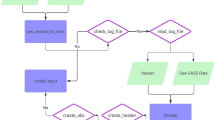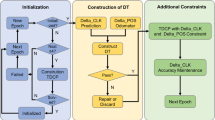Abstract
The positioning of the GPS or Chinese Area Positioning System (CAPS) software receiver was developed on a software receiver platform. The structure of the GPS/CAPS dual-mode software receiver was put forward after analyzing the differences in the satellite identification, ranging code, spread spectrum, coordinate system, time system, carrier band, and navigation data between GPS and CAPS. Based on Matlab software on a personal computer, baseband signal processing and positioning procedures were completed using real GPS and CAPS radio frequency signals received by two antennas. Three kinds of experiments including GPS positioning, CAPS positioning, and GPS/CAPS positioning were carried out. Stability and precision of the results were analyzed and compared. The experimental results show that the precision of CAPS is similar to that of GPS, while the positioning precision of the GPS/CAPS dual-mode software receiver is 1–2 m higher than that of CAPS or GPS. The smallest average variance of the positioning can be obtained by using the GPS/CAPS dual-mode software receiver.
Similar content being viewed by others
References
Ai G X, Shi H L, Wu H T, et al. The principle of the positioning system based on communication satellites. Sci China Ser G-Phys Mech Astron, 2009, 52(3): 472–488
Ai G X, Shi H L, Wu H T, et al. A positioning system based on communication satellites and the Chinese Area Positioning System (CAPS). Chin J Astron Astrophys, 2008, 8(6): 611–630
Shi H L, Jing G F, Wang A G. To develop China independent area and Global Navigation Satellite System. CAS Technology Foresight Report 2, 2008
Berberich S, Fischer S, Griesauer F, et al. AGGA-3: A next generation GNSS baseband ASIC. In: Proceedings of the 17th International Technical Meeting of the Satellite Division of the Institute of Navigation, ION GNSS 2004, Institute of Navigation, Fairfax, VA 22030, United States, 2004. 1480–1487
Liu H T. The research and development of high sensitivity GPS/Galileo dual mode navigation receiver. Doctor Dissertation. Changsha: National University of Defense Technology, 2006
Cao C. Technical development trend of satellite navigation receivier (in Chinese). Digit Commun World, 2005, 5: 55–56
Shi W P. The analysis of development on foreign satellite navigation technology (in Chinese). Aerosp Cotrol, 2004, 22(4): 30–41
TSUI J. Fundamentals of Global Position System Receivers. New York: Wiley Inter-science, 2000
Yan Y P, Ji Y F, Sun X Y. The Extensive Use of Multi-mode and Augmented Satellite Navigation Receiver, CAS Technology Foresight Report 2, 2008
Sun X Y, Ji Y F, Shi H L. GPS baseband signal processing and positioning realization based on software receiver (in Chinese). J Syst Simul, 2007, 19(24): 5832–5836
Zhao Y, Zhang Q S. Architecture of software GPS receiver and implementation of its acquisition algorithm. J Beijing Univ Aeronaut Astronaut, 2006, 32(1): 53–56
Psiaki Mark L. Block Acquisition of Weak GPS Signal in a Software Receiver. In: Proceedings of the 14th International Technical Meeting of the Satellite Division of the Institute of Navigation, ION GPS 2001, Salt Lake City, 2001: 2838–2850
Reuven S, Lev P, Yaniv I, et al. Dual frequency and dual circular polarization microstrip nonresonant array pin-fed from a radial line. IEEE Trans Antennas Propag, 2005, 53(12): 3897–3905
Lu X C, Wu H T, Bian Y J, et al. Signal structure of the Chinese Area Positioning System. Sci China Ser G-Phys Mech Astron, 2009, 52(3):412–422
Chen J Y. Terrestrial reference system, Geodetic constants and their realization (in Chinese). J Geodesy Geodyn, 2005, 25(3): 1–6
Liu G Y. Coordonates systems and their transformation used in GAMIT/GLOBK software (in Chinese). Eng Survey Mapp, 2003, 12(3): 21–23
Kaplan E D. Understanding GPS Principles and Applications. London: Artech House, 1996
Shi H L, Sun X Y, Li Z G. Principle of Positioning System Based on Communication Satellites. Beijing: Science Press, 2008
Shi H L, Pei J. The solutions of navigation observation equations for CAPS. Sci China Ser G-Phys Mech Astron, 2009, 52(3): 434–444
Li X H, Wu H T, Bian Y J, et al. Satellite virtual atomic clock with pseudorange difference function. Sci China Ser G-Phys Mech Astron, 2009, 52(3): 353–359
Cong L, Abidat Ahmed I, Tan Z Z. Analysis and simulation of the GDOP of satellite navigation (in Chinese). Acta Electron Sin, 2006, 34(12): 2204–2208
Phatak Makarand S. Recursive method for optimum GPS satellite selection. IEEE Trans Aerosp Electron Syst, 2001, 37(2): 751–754
Author information
Authors and Affiliations
Corresponding author
Additional information
Supported by the National Basic Research and Development Program of China (Grant No. 2007CB815500) and the National High Technology Research and Development Program of China (Grant No. 2007AA12z343)
Rights and permissions
About this article
Cite this article
Ning, C., Shi, H. & Hu, C. GPS/CAPS dual-mode software receiver. Sci. China Ser. G-Phys. Mech. Astron. 52, 360–367 (2009). https://doi.org/10.1007/s11433-009-0053-x
Received:
Accepted:
Published:
Issue Date:
DOI: https://doi.org/10.1007/s11433-009-0053-x




